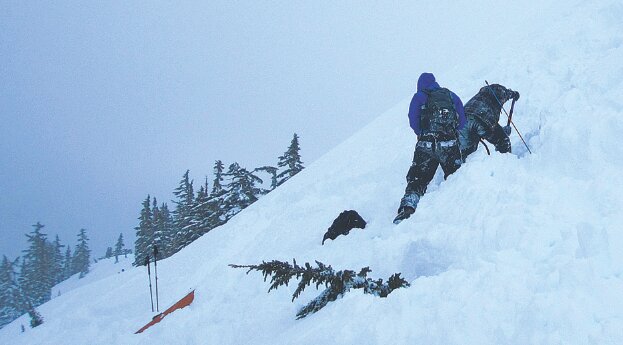 By Jason Martin
By Jason MartinAvalanches are terrifying.
Like many backcountry travelers, I’ve had a few close calls, but others have been through something far worse. They’ve been caught, or have had to rescue a partner who was caught in an avalanche.
The modern winter backcountry traveler has an arsenal of tools to locate a buried avalanche victim: a transceiver to approximate the location of the victim, a probe to pinpoint the location, and finally, a shovel to dig the victim free. A strong rescuer who has extensively practiced will be able to locate her companion quickly with a transceiver and probe. The digging part though, requires planning and hard work. It’s not uncommon for rescuers in practice scenarios to take up to 30 minutes to free a mock victim. This is way too slow.
The statistics tell us that most recreational avalanche victims are buried between 1 and 1.3 meters deep. To the uninitiated, this doesn’t sound that deep, but the reality is surprising. A burial at this depth requires the rescuer to remove up to one-and-a-half tons of snow! The proper digging strategy can mean the difference between life and death.
Choosing the right spot to start digging is essential. If you select the wrong spot you have to move significantly more snow, while simultaneously leaving the victim buried for a longer period of time. Once the probe strikes the victim, many rescuers are inclined to start digging straight down. There are three problems with this. First, if you’re standing right on top of the victim, you might collapse any air pockets that he was able to create during the avalanche. Second, digging straight down requires one to remove a great deal more snow than other strategies. And third, it’s very difficult to do first aid in a vertical hole in the ground.
Once you’ve hit the victim with the probe, leave the probe in. This will help you to estimate where you need to dig. In a shallow burial (less than 1 meter), the rescuer should dig just downhill of the probe-strike. Think of it as digging toward the victim, instead of down to the victim.
If the victim is deeper than 1 meter, then the rescuer should begin digging a terraced hole toward the victim 1.5 times the burial depth downhill of the probe-strike. The depth should be apparent to the rescuer from the probe-strike.
Start with a small hole, approximately as wide as your extended arms. If there is more than one rescuer, then the starter hole can be as wide as a body-length. Begin the excavation by digging on your knees and throwing snow off to the side. If you throw snow behind you it will create a mound that you may have to move again. You never want to move snow twice! However, if it’s a deeper burial, it’s possible that you will eventually have to terrace the hole and throw snow behind you. This usually happens once you get down approximately waist deep.
Keep the avalanche probe in sight. Don’t bury it or move it. The last thing you want to do is dig in the wrong spot or dig below the victim.
Once you’ve found the victim, focus on clearing snow from the head. Once you can reach the victim’s face, check the mouth and airway for compacted snow that may obstruct breathing.
Rescuing someone from an avalanche is hard work. Be sure that once you know where the victim is, you have a solid digging strategy. The less dialed your strategy is, the more likely it is that your partner will die.
Avalanches are terrifying. x